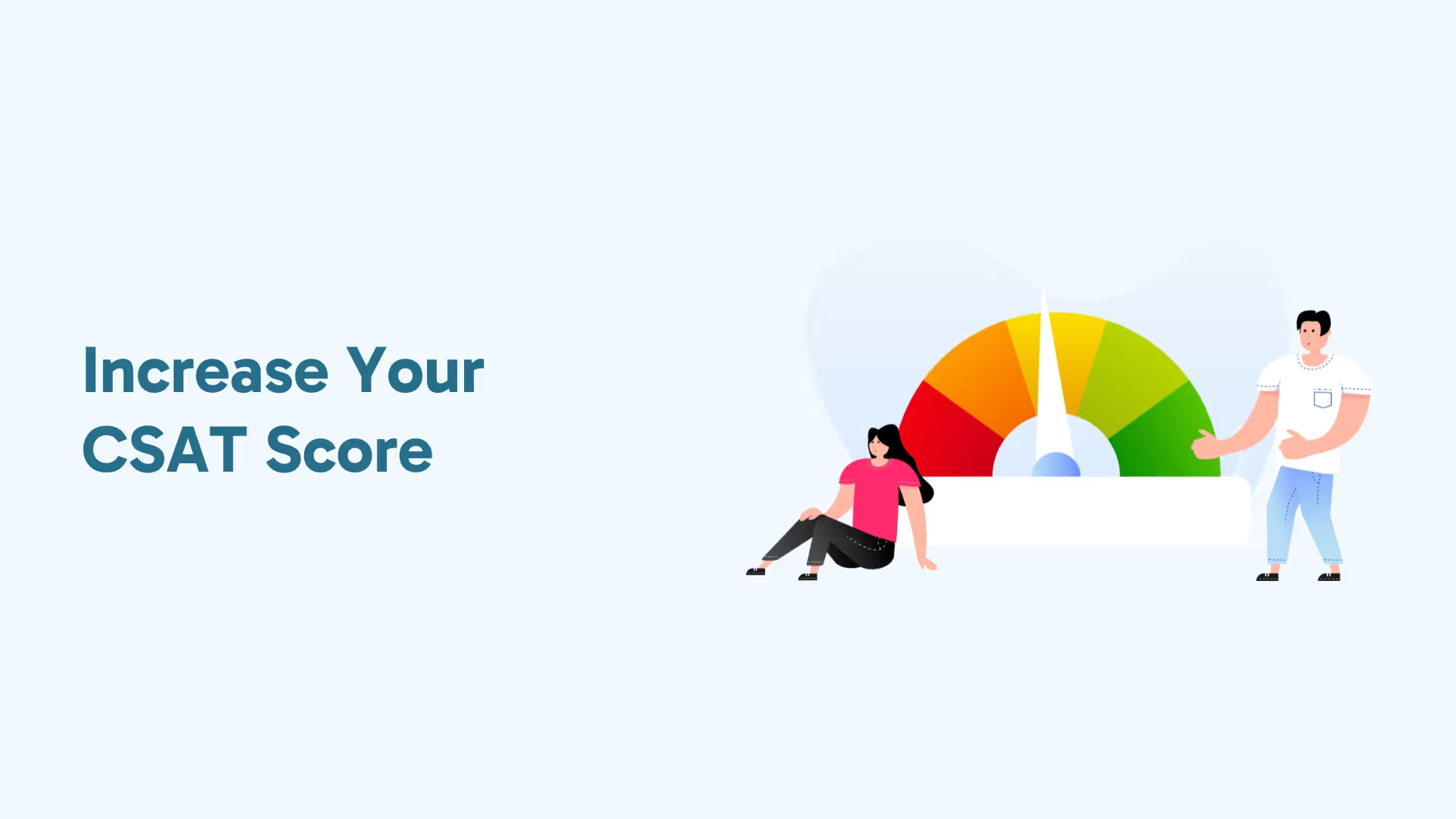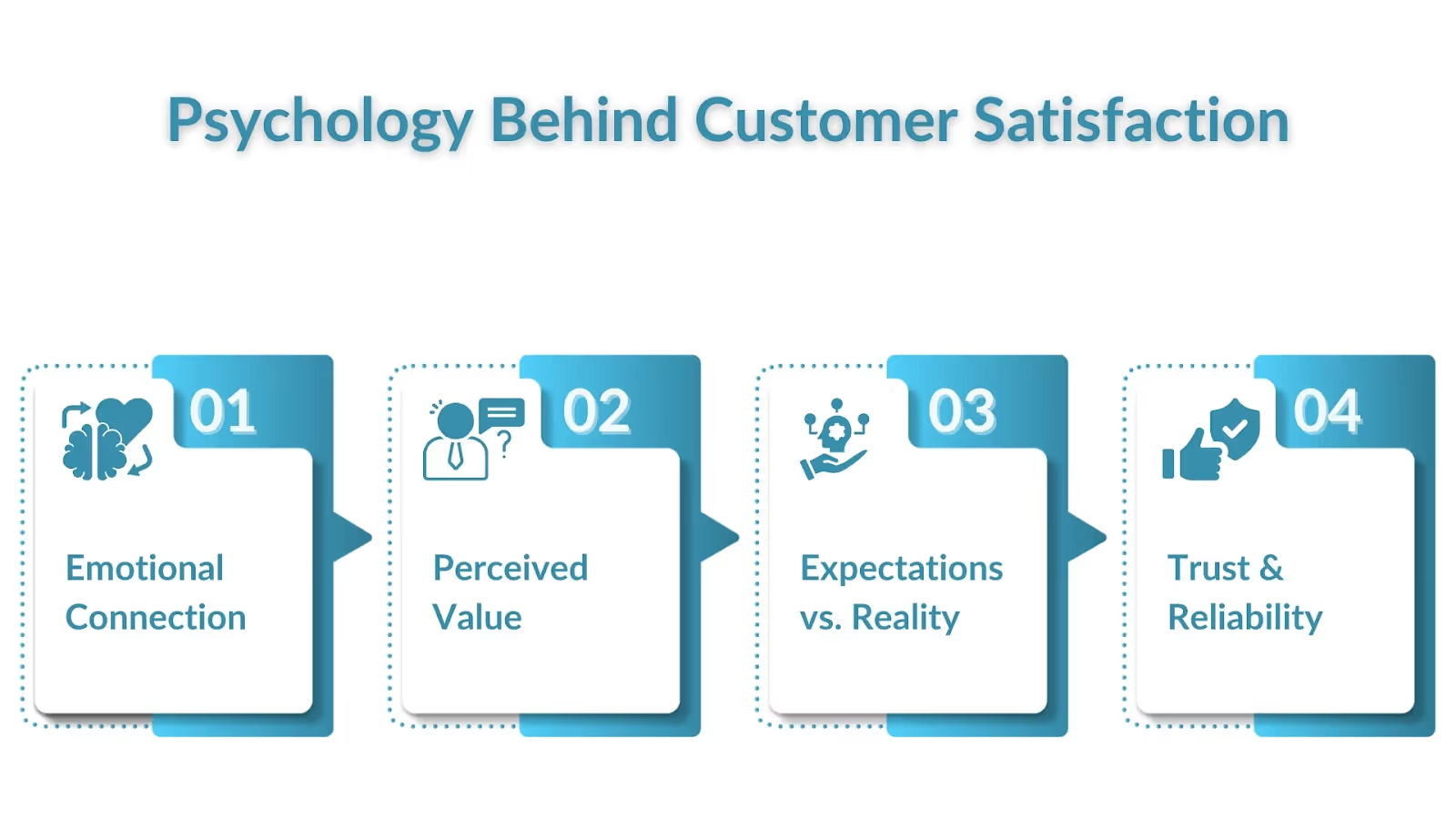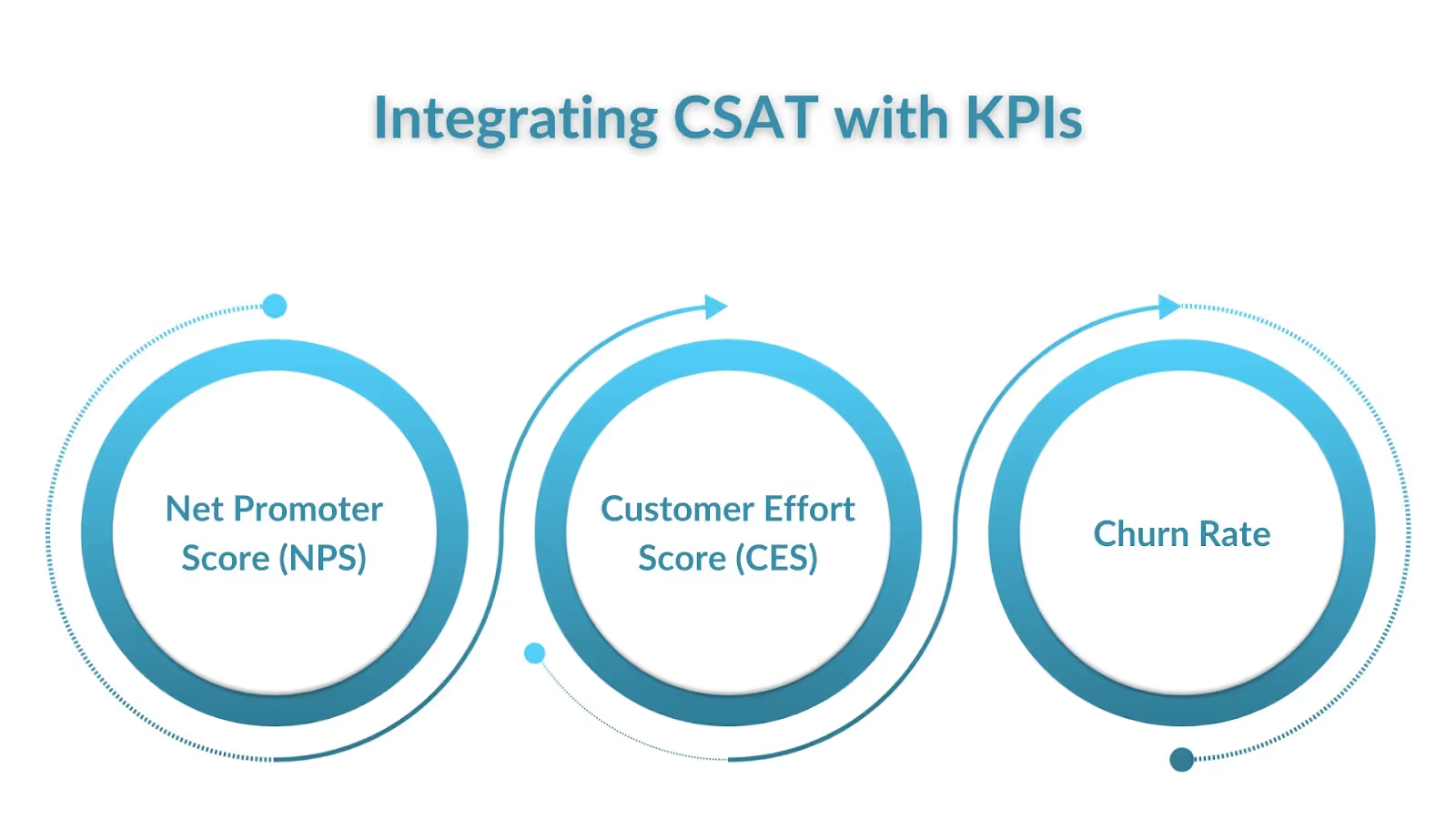Actionable Strategies to Increase Your CSAT Score

Imagine transforming your customer service metrics from mediocre to exceptional. Sounds enticing, right? Let's dive into actionable strategies to achieve just that.
What is Customer Satisfaction (CSAT)?
Customer Satisfaction (CSAT) is a metric that measures how content customers are with a company's products, services, or interactions. It typically involves asking customers to rate their satisfaction on a scale, with higher scores indicating higher satisfaction. Learning how to improve CSAT scores can be a game-changer.
Benefits of Good CSAT Scores v/s Cost of Poor CSAT Scores
Beyond the tangible benefits and costs, customer satisfaction is deeply rooted in psychology. Understanding these psychological factors can provide deeper insights into improving CSAT scores.
The Psychology Behind Customer Satisfaction

Understanding the psychological factors that influence customer satisfaction can provide deeper insights into improving CSAT scores. Customer satisfaction is often driven by emotional responses, which several key psychological factors can influence:
- Emotional Connection
Customers who feel an emotional connection with a brand are more likely to be satisfied. This connection can be fostered through personalized interactions, empathetic communication, and consistent positive experiences.
- Perceived Value
Customers evaluate their satisfaction based on the perceived value they receive. This includes the quality of the product or service, the price, and the overall experience. Enhancing perceived value can significantly improve CSAT scores.
- Expectations vs. Reality
Customer satisfaction is greatly influenced by the alignment between customer expectations and their experience. Managing expectations through clear communication and delivering consistent service can help in meeting or exceeding customer expectations.
- Trust and Reliability
Trust is a cornerstone of customer satisfaction. Customers need to trust that the brand will deliver on its promises and handle their issues effectively. Building and maintaining trust can lead to higher satisfaction levels.
Now that we have a psychological perspective, let's move on to the practical aspects. Measuring customer satisfaction accurately is crucial for any improvement strategy.
How to Measure Customer Satisfaction Score
The Customer Satisfaction Score (CSAT) quantifies customer satisfaction. It is usually measured by asking customers to rate their satisfaction with a product or service on a scale of 1 to 5 or 1 to 10. The scores are then averaged to provide the CSAT score.
Measuring CSAT
Effectively measuring CSAT is essential for understanding customer satisfaction and identifying areas for improvement. Here are the steps involved:
- Survey Creation: Create a short and focused survey that asks customers to rate their satisfaction. Questions should be clear and directly related to their experience with your product or service.some text
- Example Question: "On a scale of 1 to 10, how satisfied are you with your recent purchase experience?"
- Data Collection: Collect responses immediately after customer interactions or at regular intervals to get timely and relevant feedback. Use email, SMS or in-app surveys to reach customers easily.some text
- Timing: Post-purchase, after customer service interactions, or periodically for ongoing services.
- Score Calculation: Calculate the CSAT score by averaging the responses. This gives you a quantifiable measure of customer satisfaction.some text
- Formula: (Total Score / Number of Responses) ×100
How to Improve CSAT Scores: Strategies
Implementing effective strategies is key to improving CSAT scores. Below are detailed steps you can take to ensure systematic improvement in your CSAT scores.
- Personalize Customer Interactions
Personalization goes beyond just calling customers by their names. Tailoring interactions based on customer history and preferences can make a big difference. With advanced AI solutions like those provided by Nurix AI, you can create personalized interactions including recommendations and solutions, increasing customer satisfaction multifold. Using AI for personalized customer service has been shown to significantly improve CSAT scores in various studies.
Key Actions:
- Use AI: Analyze customer data and preferences using AI tools.
- Tailor Responses: Customize responses to meet individual customer needs.
- Offer Recommendations: Provide personalized product recommendations and solutions.
- Provide Multi-Channel Support
Offering support across various channels such as chat, email, and voice is crucial. Customers expect to reach you through their preferred medium. About 60% of customers prefer resolving issues through chat. Ensure your AI solution can seamlessly or assist agents across all channels to improve CSAT scores.
Key Actions:
- Implement AI Chatbots: Use AI chatbots to handle common queries.
- Consistency: Ensure consistency in customer service across all channels.
- Monitor Channels: Regularly update and monitor each channel for performance.
- Implement a Robust Feedback System
Collecting and analyzing customer feedback helps identify pain points and areas for improvement. Actively listening to your customers and making necessary adjustments can greatly improve CSAT scores.
Key Actions:
- Post-Interaction Surveys: Send surveys after customer interactions to gather feedback.
- AI Analysis: Use AI to analyze feedback and identify trends.
- Implement Changes: Make changes based on feedback and monitor the impact.
- Train and Empower Your Team
A well-trained team is more likely to deliver exceptional service. Regular training sessions on using AI tools and understanding customer needs are essential. Companies with regular training programs often see significant improvements in their CSAT scores, although the exact percentage can vary based on numerous factors. Empowering your team with AI-driven insights can lead to better customer interactions.
Key Actions:
- Training Sessions: Conduct regular training sessions for customer service agents.
- Continuous Learning: Provide resources for continuous learning and improvement.
- Empower with AI: Equip agents with AI tools to enhance their efficiency.
- Optimize Response and Resolution Times
Speed is of the essence in customer service. Reducing response and resolution times can significantly improve CSAT scores. Automate routine queries with AI to free up agents for complex issues. Use AI analytics to identify and eliminate bottlenecks in the service process.
Key Actions:
- AI Automation: Implement AI-driven automation for routine queries.
- Monitor Response Times: Set and monitor targets for response and resolution times.
- Streamline Processes: Use data analytics to streamline processes and reduce delays.
- Monitor and Analyze CSAT Metrics Regularly
Regular monitoring and analysis of CSAT metrics are crucial for continuous improvement. Utilize AI tools to gain deep insights into customer satisfaction trends and areas needing attention. Nurix AI offers comprehensive analytics to help you stay on top of your CSAT scores. Use data-driven insights to craft an action plan to improve CSAT scores.
Key Actions:
- Regular Reviews: Regularly review CSAT metrics and customer feedback.
- Pattern Identification: Use AI tools to identify patterns and areas for improvement.
- Adjust Strategies: Adjust strategies based on data insights to maintain high CSAT scores.
- Enhance Communication Skills
Effective communication is key to understanding and resolving customer issues. Training your team in soft skills can enhance the overall customer experience. About 86% of customers are willing to pay more for better customer service. Investing in communication training can significantly improve CSAT scores in call centers.
Key Actions:
- Communication Training: Provide training on effective communication techniques.
- Empathy and Listening: Encourage active listening and empathy in customer interactions.
- Real-Time Assistance: Use AI tools to provide real-time communication assistance to agents.
- Leverage AI for Predictive Support
Predictive support involves anticipating customer needs and proactively addressing them. AI tools can help you predict common issues and resolve them before they escalate. Predictive AI can help reduce the number of support tickets, often leading to higher CSAT scores, although the exact impact can vary.
Key Actions:
- Implement Predictive AI: Use AI to predict and address common customer issues.
- Enhance Proactive Support: Use predictive analytics to enhance proactive support.
- Update AI Models: Regularly update AI models to improve prediction accuracy.
Integrating CSAT with Other Key Performance Indicators (KPIs)

Integrating CSAT with other KPIs, such as Net Promoter Score (NPS) and Customer Effort Score (CES), can provide a comprehensive view of customer experience and business performance.
- Net Promoter Score (NPS)
NPS measures customer loyalty by asking how likely customers are to recommend the company to others. Combining NPS with CSAT can reveal not only satisfaction levels but also the likelihood of customers advocating for the brand.
- Customer Effort Score (CES)
CES measures the ease of customer interactions with a company. High CES indicates that customers can easily achieve their goals, which often correlates with high satisfaction. Integrating CES with CSAT can help identify friction points in the customer journey.
- Churn Rate
Tracking churn rates alongside CSAT can highlight the impact of customer satisfaction on customer retention. A high churn rate with low CSAT scores can indicate areas where the company needs to improve.
Common Pitfalls in Measuring CSAT
Measuring CSAT effectively requires a strategic approach. Here are some common pitfalls to avoid:
- Poorly Designed Surveys: Surveys that are too long or irrelevant can lead to low response rates and unhelpful data.
- Inconsistent Data Collection: Irregular or biased data collection can skew results, making it hard to gauge true customer satisfaction.
- Neglecting Qualitative Feedback: While numerical scores are important, ignoring qualitative feedback can result in missed insights that could improve the customer experience.
Improving CSAT requires a combination of proactive and reactive approaches. Let's explore both strategies in detail to ensure a comprehensive improvement plan.
Proactive and Reactive Strategies to Improving Customer Satisfaction
Improving customer satisfaction involves both proactive and reactive strategies. Each approach plays a crucial role in ensuring a consistently high level of customer satisfaction.
Proactive Strategies
Proactive strategies involve anticipating customer needs and addressing them before issues arise. Here are some key actions:
- Personalize Interactions Using AI: Utilize AI to analyze customer data and provide personalized interactions. Tailoring responses and recommendations to individual preferences can significantly enhance the customer experience.some text
- Example: Using AI to recommend products based on previous purchases or browsing history.
- Offer Multi-Channel Support: Provide support across various channels such as chat, email, and phone. This ensures customers can reach you through their preferred medium, improving accessibility and satisfaction.some text
- Example: Implementing chatbots for instant responses on your website and social media platforms.
- Implement Predictive Support: Leverage predictive analytics to anticipate common issues and address them proactively. This can reduce the number of support tickets and enhance customer satisfaction.some text
- Example: Sending preemptive notifications about potential service disruptions.
Reactive Strategies
Reactive strategies focus on efficiently handling customer feedback and resolving issues quickly. Here's how to implement them:
- Collect and Analyze Customer Feedback: Regularly gather feedback through surveys, reviews, and direct interactions. Use AI tools to analyze this data and identify trends or recurring issues.some text
- Example: Post-interaction surveys to gauge customer satisfaction with service received.
- Train Staff in Effective Communication: Equip your customer service team with the skills needed for clear and empathetic communication. This includes active listening, problem-solving, and handling difficult situations calmly.some text
- Example: Regular training sessions on communication best practices.
- Optimize Response and Resolution Times: Speed is crucial in customer service. Implement AI-driven automation for routine queries to free up human agents for more complex issues. Monitor and optimize response times to ensure quick resolutions.some text
- Example: Automated email responses for common queries and prioritized routing for complex issues.
Customer satisfaction varies across different industries, requiring tailored strategies. Let's examine how CSAT improvement strategies apply in various industry contexts.
Customer Satisfaction in Different Industries
Customer satisfaction varies across different industries, and strategies must be tailored to fit specific contexts.
Retail
In retail, personalization and efficient service are key. Customers expect quick responses and seamless shopping experiences, both online and offline.
BPO and Call Centers
In BPO and call centers, reducing wait times and improving first-call resolution rates are crucial. Training agents to handle issues effectively and empathetically can greatly improve CSAT scores.
Healthcare
In healthcare, patient satisfaction hinges on clear communication, empathy, and timely service. Ensuring that patients feel heard and respected can improve CSAT scores.
Technology
For tech companies, product usability and effective customer support are paramount. Providing comprehensive support resources and quick resolutions to technical issues can improve CSAT scores.
Financial Services
In financial services, transparency and trust are critical. Providing clear information and prompt, accurate support can improve customer satisfaction.
The Role of Employee Training in CSAT

Employee training is crucial for improving CSAT scores. Well-trained employees are better equipped to handle customer interactions effectively and provide superior service. Key aspects of training include:
- Communication Skills: Training staff in effective communication techniques, such as active listening and empathy, can enhance customer interactions.
- Product Knowledge: Ensuring employees are knowledgeable about products and services enables them to provide accurate and helpful information to customers.
- Use of Technology: Training employees to use AI tools and other technologies can streamline processes and improve efficiency.
Improving CSAT is an ongoing process that requires regular monitoring and adjustments. Here's how to maintain and enhance your CSAT scores over time.
Continuous Improvement: Monitoring and Adjusting Strategies
Improving CSAT is an ongoing process that requires regular monitoring and adjustments. Here's how to maintain high CSAT scores:
- Regular Reviews: Regularly review CSAT metrics and customer feedback to identify trends and areas needing improvement.
- Data-Driven Decisions: Use data insights to make informed decisions about where to focus improvement efforts.
- Agility in Strategy: Be willing to adjust strategies based on feedback and changing customer needs.
Conclusion:
Now that you know how to improve CSAT scores, it’s important to understand that it is an ongoing process that requires strategic planning and execution. By leveraging advanced AI solutions like those provided by Nurix AI, personalizing customer interactions, and continuously analyzing feedback, you can significantly enhance your customer satisfaction metrics.
If your CSAT score is stuck in a rut, let Nurix AI's custom solutions propel your customer satisfaction to new heights. Reach out today!









